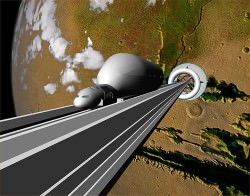Almost every part of a rocket is destroyed during the launch and re-entry into the Earth’s atmosphere. This makes spaceflight really expensive. Rocket delivery of even a single kilogram into orbit costs tens of thousands of dollars. But what if we could just place our payloads directly into orbit, and didn’t need a rocket at all?
This is the idea of a space elevator, first envisioned by the Russian rocket scientist Konstantin Tsiolkovsky in 1895. Tsiolkovsky suggested building a tower all the way up to geostationary orbit, this is the point where a satellite appears to hang motionless in the sky above the Earth. If you could carry spacecraft all the way up to the top, and release them from that tower they’d be in orbit, without the expense of a discarded rocket. A fraction more energy and they’d be traveling away from the Earth to explore the Solar System.
The major flaw with this idea is that the entire weight of the tower would be compressing down on every part below. And there’s no material on Earth, or in the Universe, that can handle this kind of compressive force. But the idea still makes sense.
Newer thinking about space elevators propose using a cable, stretched out beyond geostationary orbit. Here the outward centripetal force counters the force of gravity, keeping the tether perfectly balanced. But now we’re dealing with the tensile strength of a cable tens of thousands of kilometers long.
Imagine the powerful forces trying to tear it apart. Until recently, there was no material strong enough to withstand those forces, but the development of carbon nanotubes has made the idea more possible.
How would you build a space elevator? The most reasonable idea would be to move an asteroid into geostationary orbit – this is your counterbalance. A cable would then be manufactured on the asteroid, and lowered down towards the Earth.
As the cable extends down, the asteroid is orbited further from the Earth, keeping everything in balance. Finally, the cable reaches the Earth’s surface and is attached to a ground station.
Solar powered machines are attached to the space elevator and climb up from the surface of the Earth, all the way to geostationary orbit. Even traveling at a speed of 200 km/hour, it would take the climber almost 10 days to make the journey from the surface to an altitude of 36,000 kilometers. But the cost savings would be dramatic.
Currently, rockets cost about $25,000 per kilogram to send a payload to geostationary orbit. A space elevator could deliver the same payload for $200 per kilo.
Obviously there are risks associated with a megastructure like this. If the cable breaks, portions of it would fall to Earth, and humans traveling up in the elevator would be exposed to damaging radiation in the Earth’s Van Allen belts.
Building a space elevator from Earth is at the very limits of our technology. But there are places in the Solar System which might make much more useful places to build elevators.
The Moon, for example, has a fraction of the Earth’s gravity, so an elevator could operate there using commercially available materials. Mars might be another great place for a space elevator.
Whatever happens, the idea is intriguing. And if anyone does build a space elevator, they will open up the exploration of the Solar System in ways that we can’t even imagine.


